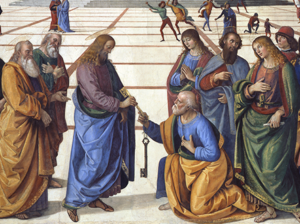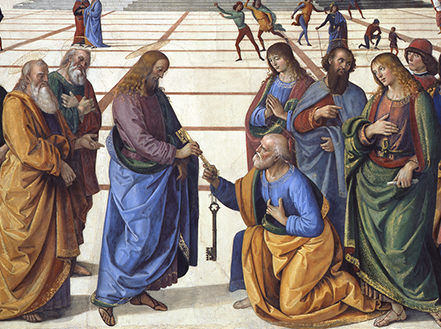
The Gospel today sets forth the biblical basis for the Office of Peter, the Office of the Papacy, for Peter’s successors are the Popes. The word “pope” is simply an English version (via Anglo-Saxon and Germanic tongues) of the word “papa.” The Pope is affectionately called “Papa” in Italian and Spanish as an affectionate indication that he is the father of the family, the Church.
Let’s look at the basic establishment of the Office of Peter in three steps.
I. The Inquiry that Illustrates – The text says, Jesus went into the region of Caesarea Philippi and he asked his disciples, “Who do people say that the Son of Man is?” They replied, “Some say John the Baptist, others Elijah, still others Jeremiah or one of the prophets.” He said to them, “But who do you say that I am?”
In asking these questions, Jesus is not merely being curious about what people think of Him. He seems, rather, to be using these questions as a vehicle through which to teach the apostles (and us) about how the truth is adequately revealed and guaranteed.
Jesus’ first two questions reveal the inadequacy of two common methods:
1. The Poll – Jesus asks who the crowds say that He is. In modern times, we love to take polls; many put a lot of weight on the results. Many people—Catholics among them—like to point out that x% of Catholics think this or that about certain moral teachings, doctrines, or disciplines. Their position is that if more than 50% of Catholics believe something then it must be true; and therefore the Church should change her teaching.
As today’s Gospel makes clear, taking a poll doesn’t necessarily yield the truth. In fact, in this case all of the assertions of the crowd were wrong. Jesus is not John the Baptist, Elijah, Jeremiah, or one of the prophets redivivus. So, running the Church by poll-taking does not seem be a model that works.
2. The Panel – Jesus now turns to a panel of experts, a “blue ribbon committee,” if you will. He asks the twelve, “Who do you say that I am?” Jesus is met with silence. Perhaps they were looking around like nervous students in a classroom, not wanting to answer lest they appear foolish. The politics on the panel leads not to truth, but to a kind of self-serving, politically correct silence.
Peter finally speaks up, but as Jesus will point out, he does not do so because he is a member of the panel, but for another reason entirely.
Hence the blue ribbon panel, the committee of experts, is not adequate in setting forth the religious truth of who Jesus is.
Through this line of questioning, Jesus instructs through inquiry. Polls and panels are not adequate in yielding the firm truth as to His identity. All we have are opinions, or politically correct silence. Having set forth this inadequacy, the Gospel now presses forth to describe the plan of God in adequately setting forth the truths of faith.
II. The Individual that is Inspired – The text says, Simon Peter said in reply, “You are the Christ, the Son of the living God.” Jesus said to him in reply, “Blessed are you, Simon son of Jonah. For flesh and blood has not revealed this to you, but my heavenly Father.”
We are taught here not merely that Peter spoke, but also how he came to know the truth. Jesus is very clear to teach us that Peter spoke rightly not because he was the smartest (he probably wasn’t), or because someone else told him (Jesus is clear that flesh and blood did not reveal this to him), or because he guessed and just happened to get the right answer. Jesus teaches that Peter came to know the truth and speak it because God the Father revealed it to him. God the Father inspired Peter. There is a kind of anointing at work here.
God’s methodology, when it comes to adequately revealing and guaranteeing the truths of the faith, is to anoint Peter.
It is not polls or panels that God uses; it is Peter.
While truths may emerge in the wider Church reflecting what is revealed, it is only Peter and his successors who can definitively set forth views whose truth is adequately guaranteed. Thus, the other apostles are not bypassed by God, but He anoints Peter to unite them and give solemn declaration to what they have seen and heard.
The Catechism says this of Peter and his successors, the popes:
When Christ instituted the Twelve, he constituted [them] in the form of a college or permanent assembly, at the head of which he placed Peter, chosen from among them …. The Lord made Simon alone, whom he named Peter, the “rock” of his Church. He gave him the keys of his Church and instituted him shepherd of the whole flock. The office of binding and loosing which was given to Peter was also assigned to the college of apostles united to its head. This pastoral office of Peter and the other apostles belongs to the Church’s very foundation and is continued by the bishops under the primacy of the Pope.
The Pope, Bishop of Rome and Peter’s successor, is the perpetual and visible source and foundation of the unity both of the bishops and of the whole company of the faithful. For the Roman Pontiff, by reason of his office as Vicar of Christ, and as pastor of the entire Church has full, supreme, and universal power over the whole Church, a power which he can always exercise unhindered.
The college or body of bishops has no authority unless united with the Roman Pontiff, Peter’s successor, as its head. As such, this college has supreme and full authority over the universal Church; but this power cannot be exercised without the agreement of the Roman Pontiff. The college of bishops exercises power over the universal Church in a solemn manner in an ecumenical council. But there never is an ecumenical council which is not confirmed or at least recognized as such by Peter’s successor (Catechism of the Catholic Church, 880-884 selected).
All of these truths point back to the moment described in today’s Gospel, when we see how God Himself chooses to operate.
Note, too, the dimension of faith we are called to have. We are to assent to the pope’s teaching and leadership not merely because we think he is smarter, or because he might have the power, riches, or other worldly means to impress us or compel our assent. No, we assent to the pope’s teaching because, by faith, we believe he is inspired by God. It is not flesh and blood in which we put our trust; it is God Himself. We believe that God has acted on our behalf by anointing someone to affirm the truth and adequately guarantee that truth to be revealed by Him.
III. The Installation that is Initiated – The text says, And so I say to you, you are Peter, and upon this rock I will build my Church, and the gates of the hell shall not prevail against it. I will give you the keys to the kingdom of heaven. Whatever you bind on earth shall be bound in heaven; and whatever you loose on earth shall be loosed in heaven.
Jesus does not merely praise Simon for a moment of charismatic insight. He goes further, declaring that He will build His very Church upon Simon, whom He names Peter (rock). Jesus does not merely mean this is a personal gift or recognition that will die with Peter. In giving him the keys, He is establishing an office. He is not merely giving Peter a personal promotion. This will be God’s way of strengthening and uniting the Church. In Luke’s Gospel Jesus says more of this:
Simon, Simon, behold, Satan demanded to have you, all that he might sift you all like wheat, but I have prayed for thee, Peter, that thy faith may not fail; and when thou hast turned again, strengthen thy brethren (Luke 22:31).
This makes clear once again that God’s plan for the Church is to strengthen one man, Peter (and his successors in the future), so that in turn the whole Church may be strengthened and united. Thus the Lord Jesus establishes not only Peter, but also his office. This is God’s vision and plan for His Church.
Many have objected to this teaching. There is no time here to provide a complete response to every objection, but frankly most of them amount to a kind of wishful thinking by those who want this text to mean something other than what it plainly does. Nothing could be clearer than the fact that Jesus is establishing Peter and an office, which will serve as a foundation for the unity and strength of His Church.
It is also true that we are living in times that have tested many Catholics who have traditionally been the biggest supporters of the papacy. For many, our current pope has been a source of controversy rather than unity. And yet the office endures; it remains our duty to pray for and respect him, and to seek to maintain unity. Concerns for some of his statements should be expressed with charity and manifest good will. Although St. Paul saw fit to express his dismay over some of St. Peter’s prudential decisions (see Gal 2:11), we should remember that St. Paul was a bishop and apostle. Thus Catholics who have concerns today would do well to work with bishops to express their concerns, whether their own bishop or one they know they can approach.
Truth be told, “If no one is pope, everyone is pope.” Without a visible head, there is no principle on earth for unity in the Church. The Protestant experiment tried to replace the pope with Scripture, giving it sole authority. Yet Protestants cannot agree on what Scripture says and have no earthly way to resolve their conflicts. While they say that authority resides in Scripture alone, in claiming the anointing of the Holy Spirit and thus the ability to properly interpret Scripture, they really place the locus of authority within themselves, in effect becoming the very pope they denounce.
I have read that some objectors think Catholics arrogant in asserting that we have a pope whom we trust to be anointed by God to teach us without error on faith and morals. But which is more arrogant, to claim that there is a pope or to in fact act like one myself?
In the end, the Protestant experiment is a failed one. Estimates place the number of Protestant denominations as high as 30,000. I think that this figure is exaggerated, but not by much. They all claim the Scriptures as their source of truth but differ on many essential matters: the necessity of baptism, “once saved, always saved,” sexual morality, and authority. When they cannot resolve things they simply subdivide.
Jesus has installed an individual in this role to manifest his office of rock and head: Peter and his successors.

